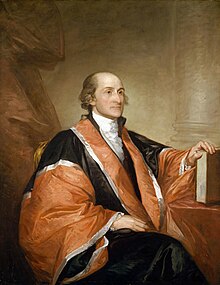John Jay
| John Jay | |
|---|---|
 |
|
| 2nd Governor of New York | |
|
In office July 1, 1795 – June 30, 1801 |
|
| Lieutenant | Stephen Van Rensselaer |
| Preceded by | George Clinton |
| Succeeded by | George Clinton |
| 1st Chief Justice of the United States | |
|
In office September 26, 1789 – June 29, 1795 |
|
| Nominated by | George Washington |
| Preceded by | Position established |
| Succeeded by | John Rutledge |
|
United States Secretary of State Acting |
|
|
In office September 15, 1789 – March 22, 1790 |
|
| President | George Washington |
| Preceded by | Position established |
| Succeeded by | Thomas Jefferson |
| United States Secretary of Foreign Affairs | |
|
In office May 7, 1784 – September 15, 1789 |
|
| Appointed by | Congress of the Confederation |
| Preceded by | Robert Livingston |
| Succeeded by | Position abolished |
| United States Minister to Spain | |
|
In office September 27, 1779 – May 20, 1782 |
|
| Appointed by | Continental Congress |
| Preceded by | Position established |
| Succeeded by | William Carmichael |
| 6th President of the Continental Congress | |
|
In office December 10, 1778 – September 28, 1779 |
|
| Preceded by | Henry Laurens |
| Succeeded by | Samuel Huntington |
| Delegate to the Second Continental Congress from New York |
|
|
In office December 7, 1778 – September 28, 1779 |
|
| Preceded by | Philip Livingston |
| Succeeded by | Robert Livingston |
|
In office May 10, 1775 – May 22, 1776 |
|
| Preceded by | Seat established |
| Succeeded by | Seat abolished |
| Delegate to the First Continental Congress from New York |
|
|
In office September 5, 1774 – October 26, 1774 |
|
| Preceded by | Seat established |
| Succeeded by | Seat abolished |
| Personal details | |
| Born |
December 23, 1745 New York City, New York, British America |
| Died | May 17, 1829 (aged 83) Bedford, New York, U.S. |
| Political party | Federalist |
| Spouse(s) | Sarah Livingston |
| Children | 6 (including Peter and William) |
| Education | Columbia University (BA, MA) |
| Signature | |
John Jay (December 23 [O.S. December 12] 1745 – May 17, 1829) was an American statesman, Patriot, diplomat, one of the Founding Fathers of the United States, signatory of the Treaty of Paris, and first Chief Justice of the United States (1789–95).
Jay was born into a wealthy family of merchants and government officials in New York City. He became a lawyer and joined the New York Committee of Correspondence and organized opposition to British rule. He joined a conservative political faction that, fearing mob rule, sought to protect property rights and maintain the rule of law while resisting British rule. Jay served as the President of the Continental Congress (1778–79), an honorific position with little power. During and after the American Revolution, Jay was Minister (Ambassador) to Spain, a negotiator of the Treaty of Paris by which Great Britain recognized American independence, and Secretary of Foreign Affairs, helping to fashion United States foreign policy. His major diplomatic achievement was to negotiate favorable trade terms with Great Britain in the Jay Treaty in 1794.
Jay, a proponent of strong, centralized government, worked to ratify the U.S. Constitution in New York in 1788 by pseudonymously writing five of The Federalist Papers, along with the main authors Alexander Hamilton and James Madison. After the establishment of the U.S. government, Jay became the first Chief Justice of the United States, serving from 1789 to 1795.
...
Wikipedia
